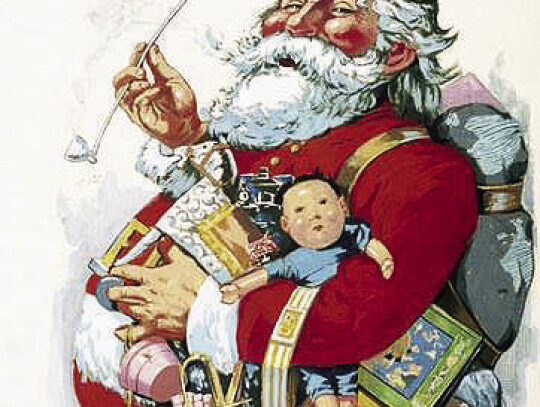Eagle Lake Remembers
Eagle Lake is just as likely to have a “Blue Norther” blowing across the prairie on Christmas Day, as to have bright, warm sunshine. Children play outside and enjoy leftover turkey sandwiches on the front porch regardless. Christmas weather in Texas and Colorado County is rarely predictable.
Each year we wonder if this might be “the year” for the surprise “White Christmas;” but mostly we enjoy snowflakes and snowmen only from popular seasonal songs, decorations with icicles and snow sprays, and our vivid imaginations. One year, however, near Christmas, Eagle Lake came close to real sleigh rides and snow castles.
The year was 1899. It was in February, just after the Christmas holidays. Eagle Lake had its biggest snowfall in history at six inches deep. People ran to and fro, most seeing snow for the first time. The lake was a center of social activity. Citizens gathered there to see if it had frozen over. In fact, it had frozen solid. With ice at one inch thick in the middle of the lake, and between three and six inches of ice along the banks, it was a local winter record. But perhaps the real record was that the temperature was said to have changed by 100 degrees within twenty-four hours to create this winter phenomenon. Sound like Texas?
Children built snowmen and snow castles, not to be outdone by the winter revelers in the North. Ingenious Eagle Lakers created local-styled sleighs along the lake by pulling out all the boats from the lake, and attaching double-tree harnesses to the prows, at the front of the boats. They located every available team of horses, hitched them to the boats loaded with excited onlookers waiting for their first sleigh rides.
The determined horses pulled the “boat-sleighs” through the snow to the delight of all. Lakeside became a Winter Wonderland, and Eagle Lake’s dreams of sleighrides in Texas became a reality. Cowbells were substituted for sleighbells, and the snowpacked ground became a trail of winter delight for all. Imagine!
Early Christmas celebrations around Eagle Lake were varied. The first settlers had simple celebrations with wild game, local vegetables such as sweet potatoes, corn, and beans. With Catholicism as the only accepted religion until independence, Catholic Masses were held where there was a priest nearby. Gifts were simple, often hand made. Sometimes boys would receive whistles made from the willow tree, and girls would receive cornhusk dolls made by hand.
Later, new local customs were introduced as the German, Polish, Czech, English, Swedish and Danish came to settle in the area. Christmas trees were introduced by Germans. New foods and pastries and musical celebrations were begun by a combination of local European cultures. The Mexican celebrations from Spanish heritage continued, and African American churches were the centers of their family celebrations with music, food, singing and family fellowship.
In 1899, local farmer G.E. Thomas wrote, “We had a nice Christmas. The boys received little knives and the girls each received a small doll, and we had a big time.” They and others had just come to settle in the Eagle Lake area from the Midwest.
William H. Harrison, Sr. remembered that it was his job always to provide the chicken or turkey for his family Christmas dinner, as he disappeared with his hatchet. He recalled that when Santa arrived, he had rubber boots on just like his dad’s.
At Lissie, much of the Christmas celebration took place in the Lissie Hall and the Church. Ed Causey Sr. recalled the men “going over to the Sandies to get the Christmas tree. In those days they would get whatever tree that they thought would look good. Most often it would be a large, wild peach tree, a beautiful tree with small purple berries on it.”
Ed Jr. remembered how children would fill paper sacks with oranges and nuts, which each child would receive on Christmas Eve. Everyone gathered to string cranberries and popcorn for the tree. Children made colored paper chains to hang. Children practiced for the Christmas Pageant, and parents brought gifts for the tree. Christmas Eve was always a night to remember at the old Lissie Hall.
Others recalled Christmas with grandparents and extended family with all the Christmas trimmings. Several recall local family traditions with oyster stew on Christmas Eve. Elfe Thomas celebrated in her fami ly’s German tradition as a child and has passed along these traditions to her own family locally through the years.
Many local families cut cedar trees to decorate, hunted wild turkeys for dinner, and enjoyed Christmas with family and neighbors. Later, wagons with hay were hitched up to carry groups of old-fashioned Carolers downtown and into the neighborhoods. Many remember the delicious German and Czech holiday pastries, and the wreaths on the old Eagle Lake bandstand. Christmas was a time to pause from work and from school to celebrate the Christ Child and the blessings of family and friends.
With mistletoe plentiful in the countryside, the local men brought in bundles to hang above the doorways in their homes and businesses on Main Street. Storefronts were decorated, owners handed out candy canes to the children, and eggnog was passed discretely to the men in the back of the barber shop and several stores. There was just nothing like a country Christmas. Happy Holidays.
.jpg)



